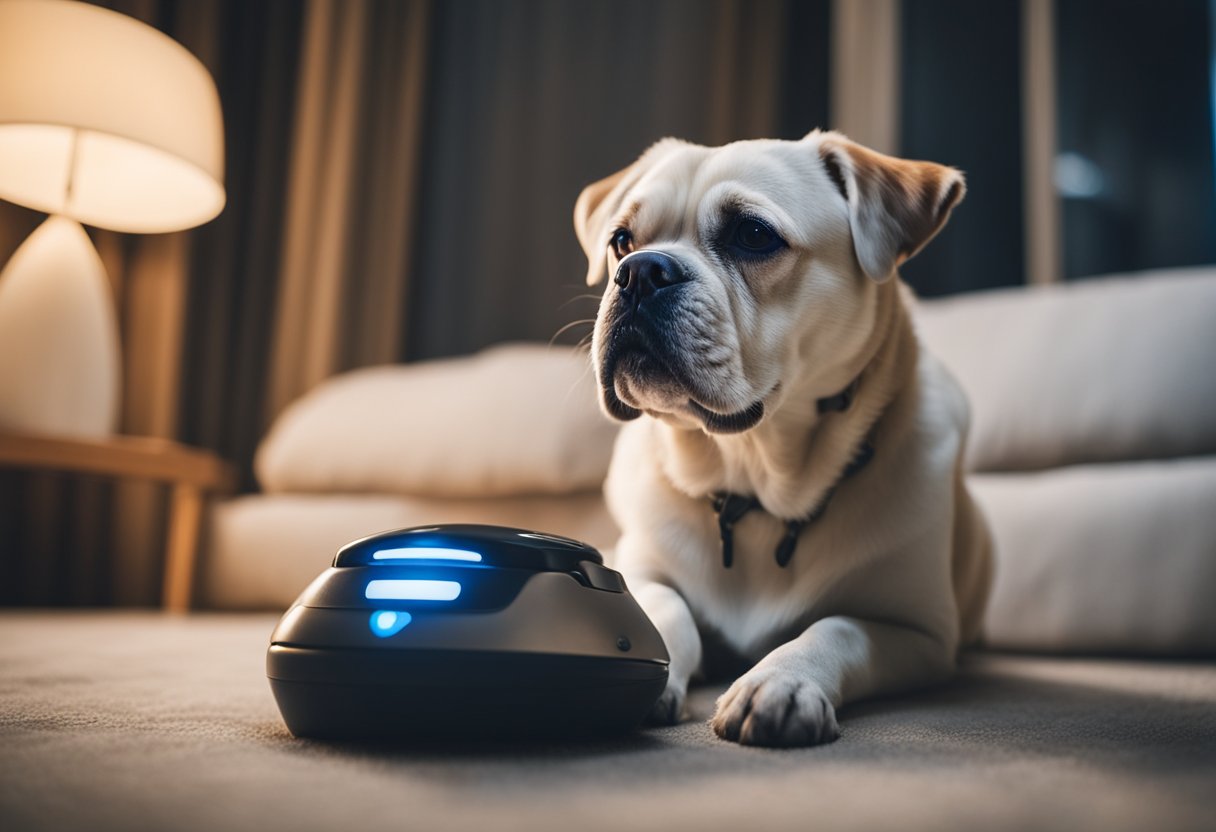The companionship of pets has always been a source of comfort for many of us, but have you ever considered that our furry friends might also experience feelings of anxiety and loneliness? Just like their human counterparts, pets are social beings that crave interaction and can exhibit signs of stress when left alone. With advancements in technology, a new player has entered the arena of pet care: AI-powered companions designed specifically for pets.
As we move forward in our technologically driven world, AI companions for pets are becoming increasingly popular, offering an intriguing solution to pet anxiety and loneliness. These innovative devices are not only capable of providing entertainment but are also tailored to engage with pets in meaningful ways, imitating social interactions that can help stave off feelings of isolation. The sophisticated design of these AI companions takes into account the mental and emotional wellbeing of our pets, showing promising potential to revolutionize how we support our furry family members when we can’t be there for them.
Key Takeaways
- Pets can experience anxiety and loneliness similar to humans.
- AI companions for pets are designed to mimic interaction and reduce stress.
- These devices represent a promising advancement in pet care technology.
The Rise of AI Companions in Pet Care
Have you ever noticed how pets seem to have their own personalities and emotions? As pet lovers ourselves, we’re always searching for ways to enrich the lives of our furry friends. Imagine an environment where our pets are not only cared for but also understood and entertained even when we’re busy or away. This is where the integration of Artificial Intelligence (AI) in pet care comes into play.
We’re excited to witness a growing trend that combines technology with compassion: AI companions for pets. These innovative buddies are designed to reduce anxiety and loneliness in our animals, ensuring they have company and mental stimulation at all times. Let’s explore how AI is making waves in the pet care industry:
- AI-Powered Tools: From symptom checkers to behavioral analytics, AI provides insightful solutions to pet care.
- Robotic Playmates: Pets can enjoy interactive playtime with robo-pets, keeping them active and engaged.
- Emotional Support: Through voice recognition and responsive actions, AI companions cater to the emotional needs of pets, offering comfort when they sense distress.
- AI Veterinarians: AI also extends into healthcare, assisting with the well-being of pets through virtual vet services.
By integrating AI into pet companionship, we’re not just providing entertainment for our pets; we’re creating a nurturing environment that attends to their emotional and physical health. It’s a step towards a future where our pets are happier, healthier, and more connected to us, even when we’re apart. The companionship of AI can truly transform the pet care experience, and we’re here for it!
Understanding Pet Anxiety and Loneliness
We all want to see our furry friends happy and at ease, but sometimes, pets struggle with anxiety and loneliness, much like humans do. Recognizing the triggers and signs of these emotional states in pets is the first step toward helping our animal companions.
Causes of Pet Anxiety
- Environmental Changes: Similar to us, pets can become anxious when their environment changes, such as moving to a new home or when they’re left alone for extended periods.
- Past Trauma: A history of negative experiences can lead to feelings of fear and anxiety in pets.
- Separation: Many pets, notably dogs, experience separation anxiety when apart from their owners.
- Age-Related: As pets age, cognitive decline can result in increased anxiety.
Signs of Loneliness in Pets
- Behavioral Changes: A pet that’s lonely might exhibit behaviors like excessive barking, digging, or attempts to escape.
- Physical Signs: Look for changes in eating and sleeping patterns, which could be indicators of loneliness.
- Seeking Attention: Increased clinginess or a constant need for attention are often cries for social interaction.
How AI Can Help Alleviate Pet Stress

We’re witnessing an exciting era in pet care with the advent of AI technology, which has the potential to dramatically reduce stress in our furry friends. By offering interactive solutions and continuous monitoring, these AI-driven tools cater to a pet’s mental stimulation and well-being, ensuring they’re happy even when we can’t be there with them.
Interactive Toys and Gadgets
Interactive toys and gadgets are revolutionizing playtime for pets. Engaging our pets with AI-powered toys like ORo’s AI Pet Robot keeps them entertained and mentally stimulated, reducing feelings of loneliness and anxiety. These smart devices can mimic the erratic movements of prey or dispense treats, rewarding pets and providing essential activity for their mental health.
Monitoring and Engagement Through AI
When we can’t be home, AI comes to the rescue. AI-enabled cameras and sensors can monitor our pets, alerting us to their needs and unusual behaviors. Through mobile apps, we can interact with our pets, giving us peace of mind and reducing our pets’ potential stress due to separation. AI not only watches over our companions but actively engages with them, offering company until we can return, easing their solitude and our worry.
Designing Effective AI Companions

When we consider how to enhance the lives of our furry friends through technology, it’s crucial that we tailor AI companions to meet their unique needs effectively. We’re committed to developing user-friendly interfaces that pets can interact with intuitively, as well as ensuring that safety and ethical considerations are at the forefront of each design.
User-Friendly Interfaces for Pets
Our mission is to create interfaces that seem natural to pets. What does this look like in practice? Consider tactile surfaces or motion sensors that respond to the swat of a paw or the nudge of a nose. Interfaces need to be:
- Engaging: To keep a pet’s attention, moving parts or changing lights can encourage repeated interaction.
- Intuitive: Pets don’t have the same cognitive abilities as humans, so simplicity is key.
For example, a system of pressable buttons designed for dogs can release a treat or activate a recorded message from their owner, making it easy for pets to learn and feel rewarded.
Safety and Ethical Considerations
Safety is non-negotiable. Here’s what we’re focusing on:
- Materials: Non-toxic and durable materials are a must to prevent any chance of harm.
- Automated shutdown: If a pet becomes too vigorous, the companion will power down to avoid overstimulation.
It’s essential to also weigh the ethical implications of integrating pets with AI. Our stance is clear: these companions should enrich pets’ lives, not replace much-needed human interaction or outdoor activity. We’re setting the bar for responsible innovation, ensuring that our AI companions serve as a beneficial addition to our pets’ daily routines.
Case Studies and Success Stories

We’ve seen some heartwarming success stories unfold as AI companions continue to make strides in improving the lives of both pets and their owners. Let’s take a quick look at a couple of these uplifting tales:
- Ageless Innovations’ Robotic Pets: Originally a part of Hasbro, Ageless Innovations took the initiative to develop robotic companion pets that mimic real animal behavior. With features like authentic sounds and responsive touch, these robotic companions have been instrumental in combating loneliness and social isolation in seniors.
- AI Chatbots as Therapists: Beyond physical robot companions, AI chatbots have also been playing the role of therapist and companion. With advanced conversation algorithms, these bots provide engagement that helps to alleviate feelings of loneliness, with Harvard Gazette highlighting the use of these artificial intelligence systems in giving people a semblance of connection.
| Case Study | Impact |
|---|---|
| AI-Driven Chatbots | Provide conversational engagement and simulated empathy to reduce feelings of loneliness. |
| Robotic Companion Pets | Offer interactive experiences to alleviate social isolation, particularly in elderly users. |
We’re thrilled to witness this technology touching lives and forming bonds that transcend the traditional scope of human-animal interaction. It’s truly a testament to the potential AI has in nurturing our emotional well-being.
Future Directions of AI in Pet Care

Have you noticed the way your pet perks up when you walk in the room? That joy can be constant with AI companions by their side. We’re exploring new horizons in pet care, capturing the essence of companionship and blending it with the advancements in artificial intelligence to help reduce pet anxiety and loneliness.
Our excitement grows as we develop AI that understands pets’ needs and behaviors. Imagine an AI tool that adapts to your pet’s schedule, offering comfort when they feel alone or anxious. The possibilities are stirring, not only for our furry friends but for us as owners, too!
- Personalized Pet Assistants: Future AI systems will learn from your pet’s unique behavior, providing tailored interaction and even initiating games based on their mood.
- Emotional Support Algorithms: Emotional recognition technology will evolve to respond to pets’ feelings, offering a soothing presence for pets experiencing stress or separation anxiety.
- Health Monitoring Features: AI monitors will keep tabs on your pet’s vital signs, providing alerts and peace of mind regarding their well-being.
- Improved Communication: Progress in translating pet sounds and body language may allow us to chat with our companions, bridging the communication gap between species.
- Robotic Companions: Advanced robotics will introduce more physically interactive AI companions capable of activities like fetching or cuddling on command.
Our connection with our pets is invaluable. Integrating AI into their care grants us a chance to amplify the love and attention they receive. As we venture into these advancements, we envision a future where our pets are never truly alone and always assured of our love, even when we’re apart.
Frequently Asked Questions

As pet owners, we’re always looking for ways to keep our beloved companions happy, especially when we can’t be with them. AI technology offers innovative solutions to soothe our pets’ anxiety and loneliness. Let’s explore some common inquiries about these high-tech friends.
What are the top AI companions available for pets to alleviate anxiety?
The market offers a range of AI companions designed to keep our pets engaged and calm. Devices like AIBO and similar AI-driven pets not only mimic realistic interactions but also learn from their environment to better suit our pets’ needs.
How can AI technology help reduce feelings of loneliness in pets?
AI companions are equipped to engage pets with interactive games, comforting sounds, and responsive movements. Their presence can simulate social interaction, reducing the risk of loneliness and anxiety in pets.
What features should I look for in an AI pet companion?
Key features include sensory stimulation, such as touch or sound responsiveness, and the ability to adapt to your pet’s behavior. Some even offer remote interaction capabilities, allowing you to engage with your pet while you are away.
Are there any studies on the effectiveness of AI companions in improving pet well-being?
Yes, there are ongoing studies examining the impact of AI companions. Preliminary results from certain studies indicate that these devices can indeed have a positive effect on pets’ stress levels and overall well-being.
How do AI companions for pets interact with animals to provide comfort?
AI companions for pets often use movement, sounds, and lights to interact with animals. These features can provide comfort by engaging the pet’s senses and mimicking the kind of stimulation they would receive from a living companion.
Can using AI companions for pets help in reducing separation anxiety when owners are away?
Absolutely. By offering a consistent presence and interactive experiences, AI companions can help pets feel less isolated. This can be especially beneficial in reducing separation anxiety when you’re not home.

